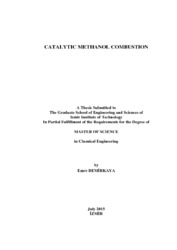Please use this identifier to cite or link to this item:
https://hdl.handle.net/11147/4436| Title: | Catalytic Methanol Combustion | Other Titles: | Katalitik Metanol Yanması | Authors: | Demirkaya, Emre | Advisors: | Şeker, Erol | Keywords: | Catalytic combustion Acid Chemical reactions |
Publisher: | Izmir Institute of Technology | Source: | Demirkaya, E. (2015). Catalytic methanol combustion. Unpublished master's thesis, Izmir Institute of Technology, Izmir, Turkey | Abstract: | Throughout this study, the major goal is to analyze the product distribution of methanol combustion at different reaction conditions, such as, varying space velocities, different initial temperatures, on 2% Pt/Al2O3 catalyst. The catalyst support material, alumina, was prepared by using a single-step sol-gel method and platinum was added by using the impregnation method. The reaction was conducted in a tubular reactor.
In this work, the maximum steady state temperature at room temperature experiment was achieved almost same within the error for 2.4 s-1 and 2.8 s-1 space velocity for fresh catalyst, and also, the conversion to CO2 during the methanol combustion reaction for all the space velocities (2.4 s-1, 2.8 s-1 and 3.1 s-1) were found to be ~100%. Another parameter that was studied was the temperatures below the room temperature. The reaction was performed at -13oC, 0oC, 7oC and 15oC temperatures. With decreasing initial temperature, the steady state temperature was also found to be decrease. This was correlated with the product distribution and with decreasing initial temperature, CO2 conversion decrement was observed..
Methyl formate was detected to be the main byproduct that was produced under all the space velocities at temperatures lower than room temperatures. The catalyst was active even at -13oC. Therefore, it showed that it could be used as a catalyst for an external heater to provide necessary heat to reach the direct methanol fuel cells operating temperature at and below room temperature. Other than the other catalysts that was investigated in literature, our catalyst does not need to heat up the reactor. Once the fuel is supplied, the system reaches the necessary operating temperature by itself. This is desirable especially in portable DMFCs. The catalytic methanol combustion system investigated in this study seems to be promising to easily replace the lithium-ion batteries for portable electronic systems, especially ones used in the military. Bu çalışma süresince metanolün, değişik alan hızı ve ortam sıcaklığı gibi değişik koşullarda %2’lik alumina destekli platin katalizör üzerinde yanması incelenmiştir. Çalışmanın amacı değişik koşullardaki ürün dağılımını gözlemlemektir. Katalizör destek malzemesi, alumina, tek basamaklı sol-jel metodu ile hazırlanmıştır ve üzerine platin takviyesi doyurma yöntemiyle gerçekleştirilmiştir. Reaksiyon tübüler reaktörde gerçekleştirilmiştir. Bu çalışmada, oda sıcaklığında yapılan deneylerde, maksimum denge durumu sıcaklığına, ilk defa kullanılan katalizör için, saniyede 2.4 ve 2.8 alan hızında ulaşılmıştır, fakat üç değişik alan hızı için de (2.4 s-1, 2.8 s-1 ve 3.1 s-1) karbondioksite olan dönüşümün yüzde 100 olduğu bulunmuştur. Çalışılan diğer parametreler ise oda sıcaklığının altındaki sıcaklıklardır. Bu anlamda, tepkimeler -13oC, 0oC, 7oC ve 15oC sıcaklıklarda gerçekleştirilmiştir. Azalan giriş sıcaklıklarıyla (ortam sıcaklıkları) birlikte, denge durumuna ulaşan maksimum sıcaklıkların da azaldığı gözlemlenmiştir. Bu durum ürün dağılım analiziyle beraber kanıtlanmaya çalışılmıştır ve azalan ortam sıcaklığıyla beraber, karbondioksite dönüşme oranının da azaldığı gözlemlenmiştir. Metil format tüm reaksiyonlarda ara ürün olarak tespit edilmiştir. -13oC’de bile katalizörün gösterdiği aktivite doğrudan metanol yakıt hücrelerinin çalışma sıcaklığını sağlayabilecek bir dış ısıtıcı kaynağı olarak kullanılabileceğini göstermiştir. Literatürde çalışılan diğer katalizörlerden farklı olarak, bu çalışmada yer alan katalizörün reaktörünün ısıtılmasına ihtiyaç duyulmamıştır. Yakıt sağlandığı sürece sistem kendiliğinden direk metanol yakıt hücresinin çalışma sıcaklığına ulaşmaktadır. Bu özellikle taşınabilir direk metanol yakıt hücreleri için arzulanan bir sonuçtur. Çalışılan sistem, taşınabilir elektronik sistemler için, özellikle askeri alanda, lityum iyon pillerinin yerini rahatlıkla alabilecek özelliktedir. |
Description: | Thesis (Master)--Izmir Institute of Technology, Chemical Engineering, Izmir, 2015 Full text release delayed at author's request until 2017.08.19 Includes bibliographical references (leaves: 42-45) Text in English; Abstract: Turkish and English ix, 56 leaves |
URI: | http://hdl.handle.net/11147/4436 |
| Appears in Collections: | Master Degree / Yüksek Lisans Tezleri |
Files in This Item:
| File | Description | Size | Format | |
|---|---|---|---|---|
| T001367.pdf | MasterThesis | 1.64 MB | Adobe PDF |  View/Open |
CORE Recommender
Page view(s)
282
checked on Apr 28, 2025
Download(s)
156
checked on Apr 28, 2025
Google ScholarTM
Check
Items in GCRIS Repository are protected by copyright, with all rights reserved, unless otherwise indicated.